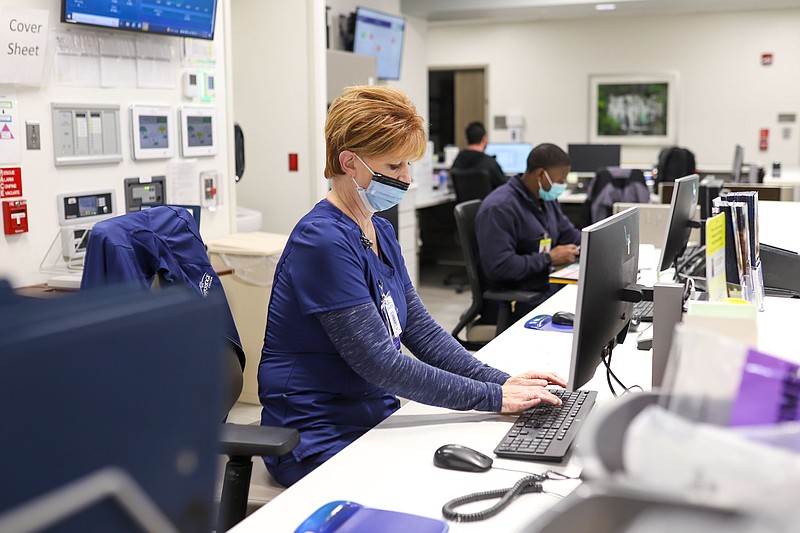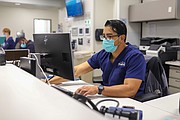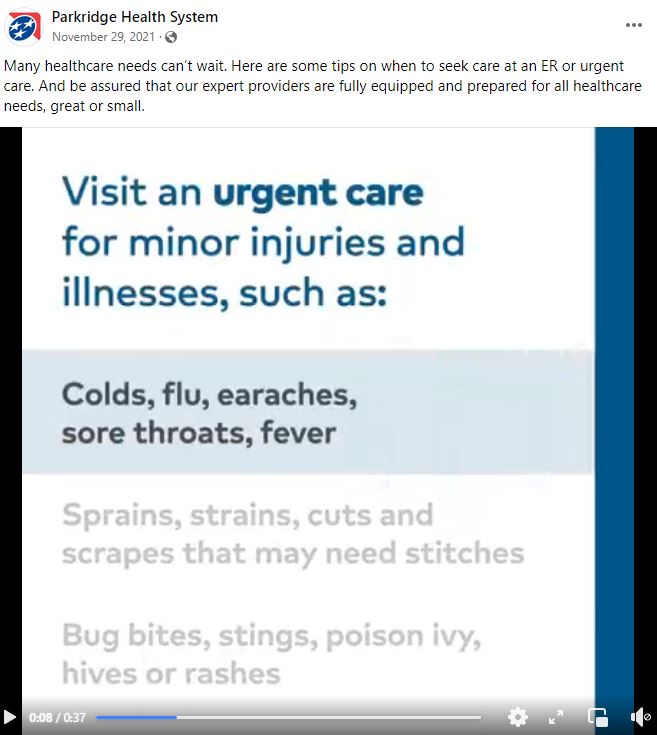Dr. Ben Cottrell was working at the Parkridge North emergency department on Lee Highway in August when an ambulance dropped off a 66-year-old man in cardiac arrest.
The man's heart wasn't pumping, which meant his brain wasn't getting oxygen, and his survival was dependent on him getting appropriate medical care, fast.
"They stopped at us because we were the nearest facility, we were able to get him in quickly and could continue the treatment that they had started," said Cottrell, medical director of emergency departments at Parkridge Health.
Chattanooga and Hamilton County have long served as a regional hub for medical care, which included seven hospitals that housed emergency departments at the start of 2020. But by 2024, patients will be able to access emergency medical care at 10 different locations across Hamilton County as Parkridge's plans to add three new "freestanding emergency departments" come to fruition.
Freestanding emergency departments offer the same, 24/7 emergency medical care as traditional emergency rooms but aren't physically attached to a hospital able to admit patients, meaning seriously ill or injured patients must be transferred by ambulance to another facility if they need more specialized care.
There's no question that timely emergency care saves lives, but the value of freestanding emergency departments has long been debated among health care industry and policy experts. That's partly because research shows the facilities lead to higher health care spending and often treat conditions that could be handled in a primary care or urgent care setting, according to Vivian Ho, a health economics expert at Rice University.
"There's a huge amount of overlap between what a freestanding emergency department sees and what is seen in an urgent care center, but the prices are 10 times higher in a freestanding emergency department," said Ho, who studied private insurance claims data from emergency department visits in Texas.
On the other hand, many patients are drawn to the convenience of freestanding emergency departments. Providers also may prefer working there because the pace is typically slower than hospital-based EDs, so they get to spend more time with patients, Cottrell said.
HOSPITAL CONNECTION
Although freestanding emergency departments are structurally separate, Tennessee law requires the facilities to be owned and operated by a licensed hospital, functioning as a satellite facility within a 35-mile radius of the hospital that is the main provider. Parkridge North is attached to one of Parkridge's behavioral health hospitals but functions as a freestanding emergency department affiliated with Parkridge Medical Center, a 275-bed hospital near downtown Chattanooga.
When it opened its doors in October 2020, Parkridge North became the first facility of its kind in Hamilton County. It's also the eastern-most emergency department in a county of nearly 370,000 people, situated less than 1 mile off Interstate 75, near the area's most rapidly growing suburban neighborhoods and several major employers. The next closest emergency department, which is connected to Erlanger East Hospital, is 3 miles away on the other side of the interstate.
(READ MORE: Fast growth and new homes in east Hamilton County create tension)
When the man in cardiac arrest was dropped off at Parkridge North in August, providers there began resuscitation protocols, which included administering drugs that would allow them to shock the man's heart, restore a heartbeat and get blood flowing to his brain. Tests revealed he was having a heart attack, so the man was stabilized and transferred to Parkridge Medical Center, where he received three stents and left the hospital 12 days later without brain damage, Cottrell said.
"That story would not happen if we had not had Parkridge North ER and he had to go into town to get treatment," Cottrell told a state board charged with deciding if Parkridge should be allowed to build a similar freestanding facility roughly 18 miles north in Soddy-Daisy.
Since Parkridge North on Lee Highway began treating patients, Parkridge -- which is owned by the for-profit, Nashville-based HCA Healthcare -- gained state approval to construct and operate two more freestanding emergency departments in the county.
Parkridge started construction in 2022 on a $15 million freestanding emergency department near Camp Jordan in East Ridge -- a 2 mile drive from Parkridge East Hospital, which also houses an emergency department. The Camp Jordan facility will be less than 9 miles from Parkridge North, and, as with that freestanding unit, is less than 1 mile off I-75. It's expected to open in 2023.
The Soddy-Daisy emergency department, a $16 million project, was approved in 2022 and is projected to open in 2024, according to a state application for the project. Though more geographically isolated and rural than the other locations, Soddy-Daisy is experiencing an influx of new development, particularly single-family homes. The next closest emergency department is just under 10 miles away at CHI Memorial's hospital in Hixson.
Both new emergency departments will include 12 emergency room beds, with a trauma room, diagnostic capabilities and support services, including CT, X-ray, ultrasound, on-site laboratory and pharmacy.
It also means that Parkridge, despite being the smallest of three acute care hospital systems in Chattanooga, will own and operate five emergency departments in Hamilton County -- more than any of its competitors. Parkridge Medical Center near downtown Chattanooga is home to the system's original emergency department.
Erlanger Health System, the Chattanooga region's largest health system and only safety net provider, has the second most facilities with emergency departments in the county -- Erlanger Medical Center, Erlanger East Hospital and Erlanger North. Erlanger North recently closed inpatient services and now functions as a freestanding emergency department.
In addition to the Hixson hospital, CHI Memorial houses an emergency department at its main hospital in Chattanooga.
Six additional emergency departments, two of which are freestanding (Erlanger Sequatchie Valley and Parkridge West), are located in counties that share a border with Hamilton.
ECONOMICS VS. ACCESS
In addition to increasing health care spending, another common opposition to freestanding emergency departments is that increased competition with hospital-based facilities could threaten the financial viability of services only hospitals can provide, such as trauma and neonatal care.
Proponents of freestanding emergency departments contend they increase access to vital emergency care for people in underserved areas, relieve the burden on overwhelmed hospital emergency facilities and get ambulances back in service quicker.
"Travel times through town are unpredictable, and many times slow and stagnant, particularly at rush hours," Cottrell said. "We're offering emergency care close to home, close to work, keeping people out of the traffic delays -- delays that not only are inconvenient but, during a medical emergency, very detrimental to someone's health."
Ho agrees that freestanding emergency departments appeal to patients because they're conveniently located and allow them to avoid some of the hassles associated with emergency departments inside hospitals, such as longer wait times. But if freestanding emergency departments didn't exist, some of those patients would have waited to go see their regular doctor, gone to an urgent care or not sought medical care at all. Between those options, emergency care is by far the most expensive, Ho said.
"The problem is that the insurer has to pay for those services, and it raises premiums for everyone in the area," Ho said. "Not by a lot -- but if you're wondering why health insurance premiums go up, it's mostly price, but it's part utilization. Well, this is utilization of a very high-price service."
Research also shows that freestanding emergency departments tend to locate in populated, affluent areas where there are more people with good health insurance in order to pick up extra business. Then, if the patients need inpatient care, they can be transferred within that particular hospital system as opposed to a competitor.
"It's a grab for market share by hospital systems to try and get more patients, and it's lucrative," Ho said.
She believes more education is needed so that patients can make informed decisions about which level of care is best suited for their condition.
"A lot of what (freestanding emergency departments) end up providing once they open is urgent care services, so there really isn't a need, and it's only going to raise spending and costs for patients," she said.
Dr. Cedric Dark, who researches the freestanding facilities at Baylor College of Medicine and treats patients in both traditional and freestanding settings, agrees that -- from an economic standpoint -- the key is to match patients with the most cost-effective resources that can meet their needs. However, patients are "notoriously bad" at making those judgment calls, he said.
(READ MORE: Turned away from urgent care -- and toward a big ER bill)
For example, an urgent care clinic staffed by a nurse practitioner is "completely inadequate" to handle complaints of chest pain, because most are not capable of performing the tests needed to assess whether or not the person is having a heart attack.
"So, those patients wind up getting sent from their urgent care centers or from their retail clinics to the emergency room, appropriately," Dark said. "On the other hand, you have people that come to the ER for things like a medication refill, which they could have done in another place and another location that didn't necessarily require all the resources of the emergency department."
Parkridge spokesperson Michelle Heron said in an email that the health system never discourages patients from seeking emergency care but does work to educate the public via social media and Parkridge's website on when to go to an urgent care clinic vs. an emergency setting.
While Dark said he believes it's best to make emergency care as accessible as possible, one issue with freestanding units is that patients may go there under the impression that they're going to an urgent care or some other retail clinic and then encounter sticker shock when they receive a bill akin to a traditional emergency room visit.
"The public should realize that they're pretty much the equivalent of a hospital-based ER," he said. "It's just you don't have the rest of the hospital there."
PRICE OF CARE
From Cottrell's perspective, it's hard to put a price tag on care when lives are at stake, pointing to the man who came to the Lee Highway facility with a heart attack.
"What would be the cost of that gentleman's care had he waited and got on down into town and got treatment?" Cottrell posed. "No. 1, he probably would've been dead. But No. 2, he certainly would have had some irreversible brain damage to deal with, and certainly that would be a cost."
Patients who need to be admitted can choose any local hospital and don't have to stay within the Parkridge system, he said.
"So if you have a medical emergency, and the freestanding ER is the closest ER to you, then we can start treatment, stabilize you," Cottrell said. "If it is something that needs admission, we can arrange a transfer to the appropriate destination facility for you to get the rest of the care."
There are also several key differences between emergency departments and other health care providers. Not only are emergency departments open 24/7, federal law requires emergency departments to see all patients regardless of their insurance status or ability to pay.
On the other hand, doctor's offices and urgent cares usually require health insurance or payment up front, Dark said.
"If you don't have insurance, or you're not paying cash, you can't go to those other places freely," he said. "The ER serves as sort of the backstop for the rest of our health care system."
After dropping off in the early days of the COVID-19 pandemic, emergency department utilization has nearly rebounded to pre-pandemic levels, according to Parkridge officials. The aging population and health care workforce shortages are expected to place even more strain on hospital systems and emergency services.
With each of the new facilities located in parts of the county where the population is surging, Ho said it appears that much of Hamilton County's increase in freestanding emergency departments is a population growth response.
"If you have an influx of people, particularly people with good jobs, with good insurance, then that's going to cause the health care systems to respond and to try and get more of those admissions," she said. "So the question really comes down to, if they put in this additional freestanding emergency department, do they just take patients away from another facility, or do they cause more patients to use emergency rooms who would not have otherwise?"
Cottrell said he sees the growing number of emergency facilities in Hamilton County as the health care system "trying to evolve to meet the needs and desires of our patients and our customers."
Admission percentages from the emergency departments across the area, he said, range anywhere from about 9% up to about 22% at the busiest departments that treat the sickest patients.
"The rest of those patients could have been taken care of in a freestanding ER," he said, acknowledging that sometimes convenience comes at a price.
"If you buy a gallon of milk at the 7-Eleven, it's going to cost more than if you went down to Publix and got it," Cottrell said. "So yeah, there is a cost associated with it, but you also get the convenience and the little quicker care."
Health care reporter Elizabeth Fite is looking for patients willing to share their experience in a local emergency department.
Contact Elizabeth Fite at efite@timesfreepress.com or 423-757-6673.


